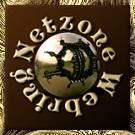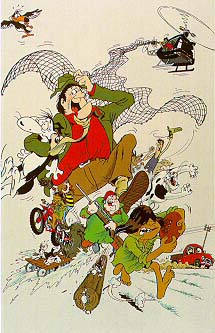![]()
Coasts
Rivers/Lakes
Lowlands/Plains
Geysers/Mud
Glaciers
Mt. Ruapehu
Mt. Cook
White Island
A Maori Legend
![]()
Abbotsford
Aramoana
Ballantynes
Brynderwyns
Cave Creek
Hawkes Bay
H.M.S. Orpheus
Influenza
Mt. Erebus
Mt. Tarawera
Rainbow Warrior
Seacliff Hospital
Tangiwai
Wahine
![]()
Annie Aves
Ata-hoe
Daisy Basham
Jean Batten
Minnie Dean
Mabel Howard
Margaret Mahy
Kath Mansfield
Kate Sheppard
Kiri Te Kanawa
Catherine Tizard
Murray Ball
Charles Goldie
Edmund Hillary
Richard Pearse
Lord Rutherford
Charles Upham
![]()
NZ FAQ--Funny
NZ Links
Credits
"I think the biggest thrill I got, was getting my first book published. The other thing was getting my first work accepted by Punch magazine in London. I badly needed that because we were starving to death at the time! -- that was in 1970." --Murray Ball. Murray Ball, New Zealand's most successful strip cartoonist, was born in Fielding in the Manawatu in 1937. The early part of his life was spent variously in New Zealand, Australia and South Africa. In his childhood he displayed an early talent and often copied characters like from Walt Disney or Tom and Jerry. In his younger days Ball had a desire to follow in his father's footsteps and play for the All Blacks, however he missed selection, though he was a brilliant mid-field attacking back and played for the Junior All Blacks in 1959. Little could this young player know that his character 'Dog' would one day be the All Blacks mascot. While waiting for his first year of university to commence he was employed as a cadet reporter for the Dominion newspaper in Wellington. After three months he realised the work didn't suit him, he was too shy and didn't like talking to people. He left to take up a position as a cartoonist with the Manawatu Times staying two years until he decided to go freelancing. These were difficult times financially and Ball took a job teaching which supplied an income for the next three years. In 1969, the family shifted to England, where Murray freelanced achieving recognition when the satirical magazine 'Punch' accepted his cartoon, 'Stanley', for regular publication. This had also been published by the Listener in the late 1960's and was to become the longest-running cartoon strip in the history of Punch. 'Stanley' was syndicated in the United States, Australia, New Guinea and Italy. Another source of income while in Britain came from illustrating children's comics. After five years Ball returned to New Zealand, but continued to send work to Punch until a mail strike eliminated that as a source of regular income.
Ball settled in Gisborne and in 1975 began work on 'Footrot Flats'. The Gisborne Herald turned the comic strip down and Ball submitted it to the Evening Post who started publishing it in 1976. Eventually syndicated in more than 120 publications worldwide, it was set on a New Zealand farm and surrounded the life of a rather optimistic farm dog, his owner Wal Footrot and the various people and animals they came into contact with. At that time Ball and his wife, Pam, lived on a farm near Gisborne. Many of the characters in 'Footrot Flats' were loosely based on people and creatures Ball knew: Wal's shape was based on a cousin. Horse was based on a tough stray cat that used to hang around the farm. Like the cat in the 'Footrot Flats' strip the real Horse never backed down. The Dog's attitudes, appearance and behaviour came from Finn, Murray's border collie, who died on October 5th, 1998. Finn was 16 and when he died Ball was shattered. This led directly to the ending of the comic strip: To Footrot Flats Readers, The time has come to end Footrot Flats. No dog lives forever and eventually you have to say 'Thank you mate. You have done all a man could ask of you' and let him rest. The dog has carried my family since the kids were at primary school. They are now adults and living their own lives. If the dog were real his muzzle would be grey and his eyes dimmer, gentler and more tolerant than they were in his youth. It is time to leave him warming his stomach in the sun, twitching and jerking as he defeats the Murphy dogs, Major or the mighty Horse, time and time again in his dreams. I will miss him very much. He has been my ghostly companion for twenty years. He has become part of the farm. His spirit is everywhere. To the readers who have shared his failures and occasional successes with such loyalty and affection, thank you. And the dog? If you want to see him again he's the dog tied to the fence with a piece of baling twine or the heading 'dog' floating weightless above a farm gate or the black dot gliding over the hills like an ant across a billiard table. The farmer's words made flesh - that's him. Goodbye dog. See ya around. Murray Ball It was in his last book that Murray Ball had planned on revealing the Dog's real name, given to him by 'Aunt Dolly' when he was just a puppy. This name so embarrassed Dog that he had never allowed it to be published. Eventually Ball decided against the huge revelation realising that no matter what name he chose it could never be as bad as the ones millions of readers had anticipated over the years.
During the life of the comic strip there followed a musical (a resounding success in both Australia and New Zealand), Footrot Flats Theme Park in Auckland, and numerous soft toys including limited edition sheepskin versions of Dog. There was also an award-winning film released in 1986. This drew the largest opening week box office of any film release in New Zealand at the time. The theme song was 'A Slice of Heaven' by Dave Dobbyn; this became the biggest selling record in Australia for 1987. In the film, neighbour Cooch's prize stag is stolen by the dastardly Murphys, who live across the river. 'Footrot Flats' is about Dog's attempts to help, his facing of the Murphy's dreaded 'hellhounds', and how Dog gets to know Cooch's bitch, Jess, intimately........ The movie was done in collaboration with master playwright Roger Hall, it was six years in development and took fifteen months to make; it was also New Zealand's first full-length animated feature film. Though Ball ceased drawing the strip back in 1994 there are over 27 volumes of collections that continue to sell widely. He continues to write but at a much slower pace than he did during the days of 'Footrot Flats'.
|



